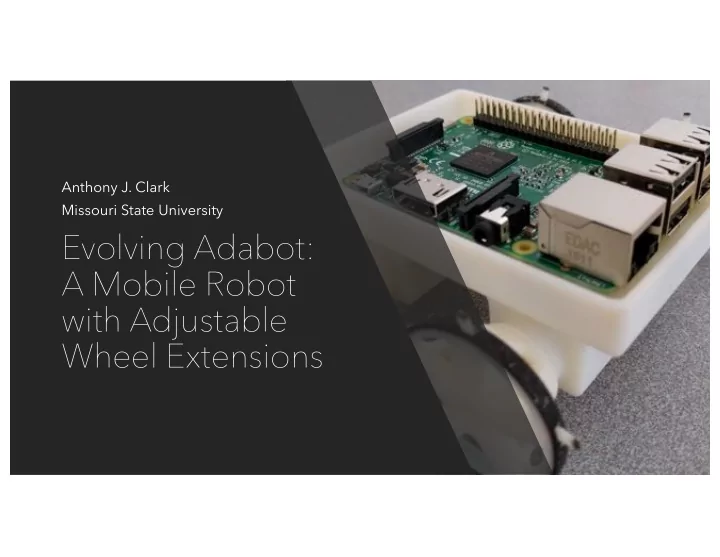

Anthony J. Clark Missouri State University Evolving Adabot: A Mobile Robot with Adjustable Wheel Extensions
Motivation: Search and Rescue anthonyjclark.com Approach for locating victims of a natural disaster • Use a swarm of inexpensive and expendable robots • Small and less likely to disturb environment • These robots spread out and search an area • They are equipped with GPS and two-way radios • Victims can grab the robot and ask for help
Issues: Search and Rescue anthonyjclark.com Robots must navigate rough and varied environments • smooth and firm (pavement) • loose and rocky (gravel) • loose and uneven (wooded areas) • unexpected failure • obstacles of different shapes and sizes • dynamic obstacles • swarm intelligence
Related Work anthonyjclark.com Active Suspension [Grand 2004] ASGUARD [Eich 2008] Tri-Wheel [Smith 2015] RHex [Saranli 2001]
Reconfigurable Wheels anthonyjclark.com [Kim 2014] [She 2015] Transleg [Wei 2016] TurboQuad [Chen 2017]
Adabot ( Adaptive Robot ) anthonyjclark.com Simple, extensible design Configure: • the wheel radius • the number of wegs Online: • adjust wheel extension amount
Weg Mechanism anthonyjclark.com
Weg Extension anthonyjclark.com
Adabot Hardware anthonyjclark.com Prototype specifications • Raspberry Pi 3 Model B • A-Star 32U4 control board • 4 drive motors with encoders • 4 linear servos for controlling wegs • 3 forward IR distance sensors • A 9-axis IMU • Wireless communication • A 2200 mAh NiMH battery pack
Physical Parameters anthonyjclark.com (Top-Down View) (Wheel Side View) Weg Count Wheel Base Track Width Wheel Radius
Physical Parameters anthonyjclark.com (Top-Down View)
Constraint Violation anthonyjclark.com (Top-Down View) (Top-Down View)
Control Parameters anthonyjclark.com start Angular Wheel Rate (Retracted) Mobility Threshold Weg Extension Timeout Mobility Duration Angular Wheel Rate (Extended) Weg Extension Percentage
Evolutionary Optimization anthonyjclark.com Differential Evolution • evolutionary algorithms are specifically targeted at problems that re not differentiable • a standard algorithm for real- value optimization problems
Evolutionary Robotics anthonyjclark.com • The intersection of robotics and evolutionary computation called Evolutionary Robotics • These algorithms work on a population of candidate solutions, and require a large number of tests (called fitness evaluations ) • Most studies use simulation • Advantages: faster, safer, less expensive • Disadvantages: the simulation will not not match reality • For this study we are using ROS and Gazebo
ROS and Gazebo anthonyjclark.com ROS is a set of libraries and middleware that enable the reuse of robotics software (access to a large amount of quality software). For example: • One node reads wheel encoder data and emits angular wheel rates • Another node reads IMU data and emits localization information • A third node uses information from both of these to detect poor mobility ROS runs on the Linux distribution supported by RPi • We can use the same software in simulation as we do on the real device
ROS Graph anthonyjclark.com
Simulation Environments anthonyjclark.com Step Environment • cannot drive over without wegs • provides a baseline comparison for other environments Rocky Environment • cannot drive over without wegs • randomly generated rocky peaks
Experiments anthonyjclark.com Two experiments (40 replicate experiments each): Step Environment • 5 repeated trials • Up to 2 outliers are removed • 20 seconds per trial • Fitness is the average maximum speed Rocky Environment • 5 repeated trials • Up to 2 outliers are removed • 30 seconds per trial • Fitness is the average maximum speed
Evolutionary Results anthonyjclark.com
Evolved Parameters anthonyjclark.com
Step Environment anthonyjclark.com
Rocky Environment anthonyjclark.com
Summary anthonyjclark.com • I presented a simple transformable-wheel device • The presented mechanism can be scaled up and down quite easily, and • The mechanism can be configured with a range of different weg counts • Variable extension
Future Work anthonyjclark.com 1. Validation experiments with the physical device 2. Simulate and fabricate compliant wegs 3. Improve controller using adaptive control techniques 4. Combine with other modes of locomotion
anthonyjclark.com Acknowledgements The authors gratefully acknowledge the contributions and feedback on the work provided by Megan Clark and Professors Philip McKinley and Jared Moore. I would also like to thank Keith Cissell, Dillon Flohr, Dersham Schmidt, and Daniel Warken. Garren Ijames, Michael Brattin, Jesse Stewart, Kyle Finter, Brett Spatz, and Dr. Razib Iqbal. Missouri State University
References anthonyjclark.com C. Grand, F. Benamar, F. Plumet, and P. Bidaud, “Stability and traction optimization of a reconfigurable wheel-legged robot,” The International Journal of Robotics Research , vol. 23, no. 10-11, pp. 1041– 1058, 2004. M. Eich, F. Grimminger, and F. Kirchner, “A versatile stair-climbing robot for search and rescue applications,” in Proceedings of the 2008 IEEE International Workshop on Safety, Security and Rescue Robotics , Oct. 2008, pp. 35–40. U. Saranli, M. Buehler, and D. E. Koditschek, “RHex: A simple and highly mobile hexapod robot,” The International Journal of Robotics Research , vol. 20, no. 7, pp. 616–631, 2001. L. M. Smith, R. D. Quinn, K. A. Johnson, and W. R. Tuck, “The Tri-Wheel: A novel wheel-leg mobility concept,” in Proceedings of the 2015 IEEE/RSJ International Conference on Intel ligent Robots and Systems (IROS) , Sep. 2015, pp. 4146–4152. W.H.Chen, H.S.Lin, Y.M.Lin, and P.C.Lin, “Turboquad: A novel leg-wheel transformable robot with smooth and fast behavioral transitions,” IEEE Transactions on Robotics , vol. PP, no. 99, pp. 1–16, 2017.
Thank You anthonyjclark.com
Recommend
More recommend